Financial Reporting: Accounting Concepts and Qualitative Features
VerifiedAdded on 2023/06/18
|6
|1345
|198
Report
AI Summary
This report provides an overview of accounting in business, focusing on the systematic recording of transactions and the preparation of financial statements for analyzing a business's financial position. It highlights five key accounting concepts: accrual, cost, going concern, business entity, and materiality, explaining their application with examples. Additionally, the report discusses the qualitative features of financial reports, including understandability, relevance, reliability, and comparability, which enhance the usefulness of financial information for users. The report concludes that adherence to accounting concepts and principles is crucial for preparing accurate and comprehensive financial statements.
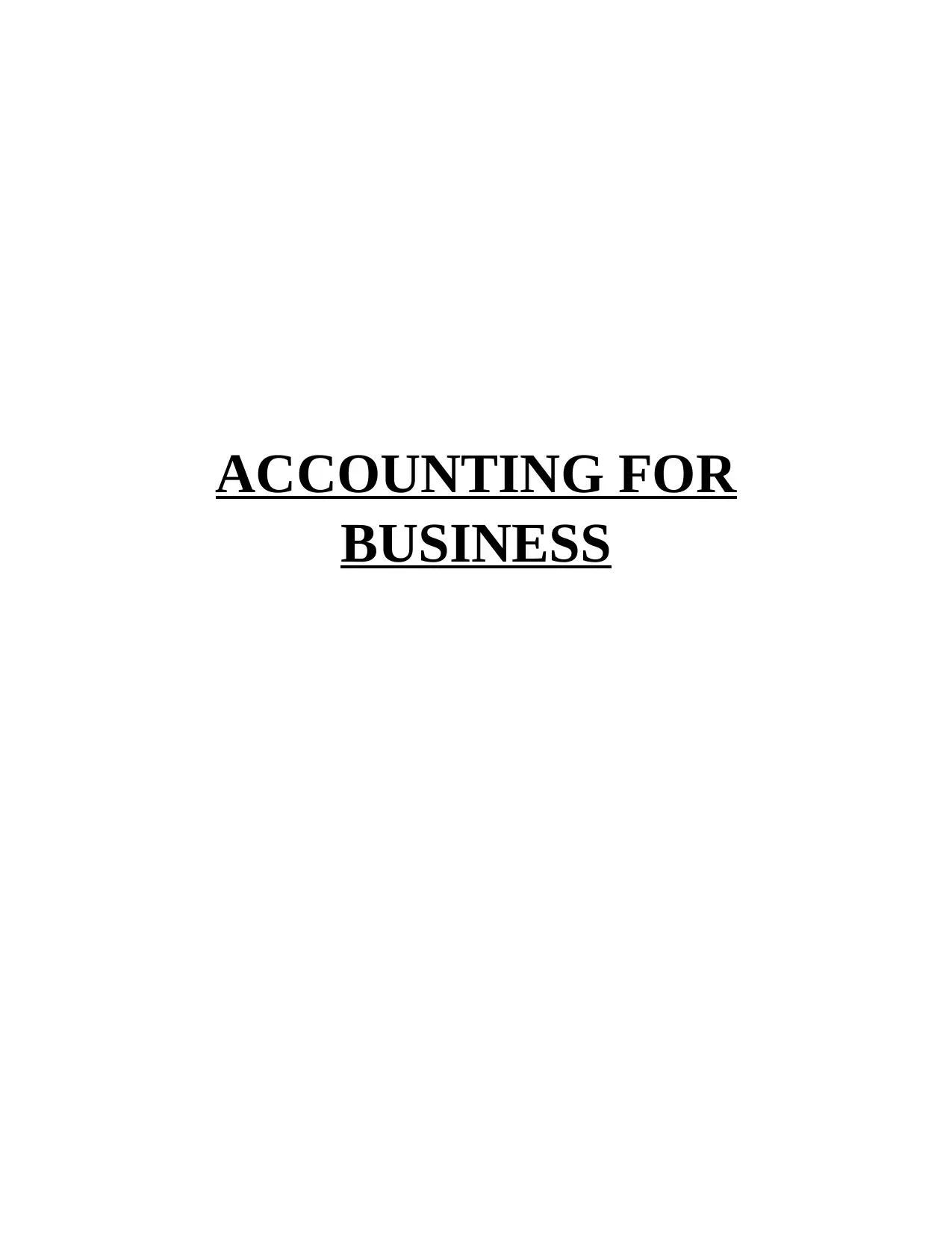
ACCOUNTING FOR
BUSINESS
BUSINESS
Paraphrase This Document
Need a fresh take? Get an instant paraphrase of this document with our AI Paraphraser
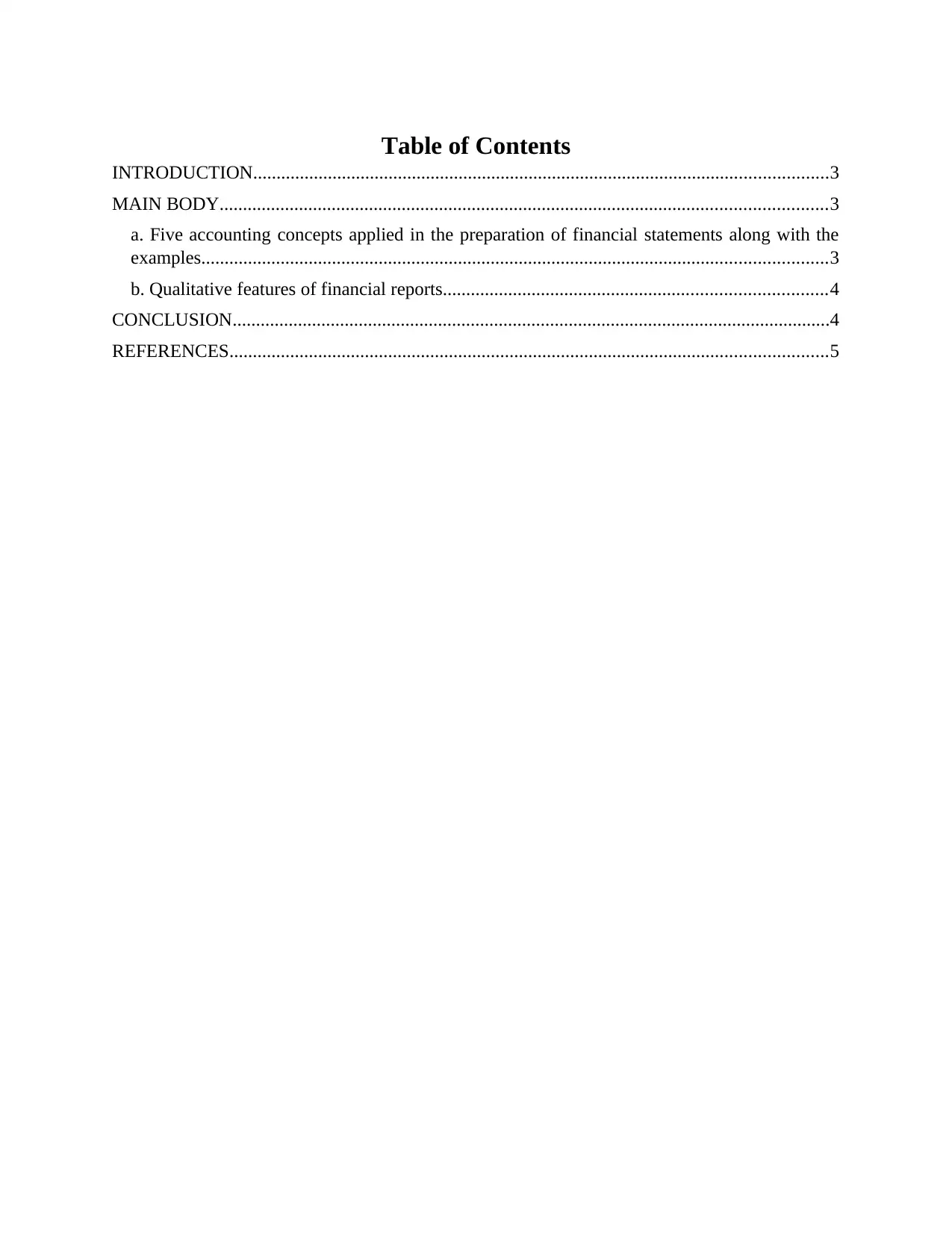
Table of Contents
INTRODUCTION...........................................................................................................................3
MAIN BODY..................................................................................................................................3
a. Five accounting concepts applied in the preparation of financial statements along with the
examples......................................................................................................................................3
b. Qualitative features of financial reports..................................................................................4
CONCLUSION................................................................................................................................4
REFERENCES................................................................................................................................5
INTRODUCTION...........................................................................................................................3
MAIN BODY..................................................................................................................................3
a. Five accounting concepts applied in the preparation of financial statements along with the
examples......................................................................................................................................3
b. Qualitative features of financial reports..................................................................................4
CONCLUSION................................................................................................................................4
REFERENCES................................................................................................................................5
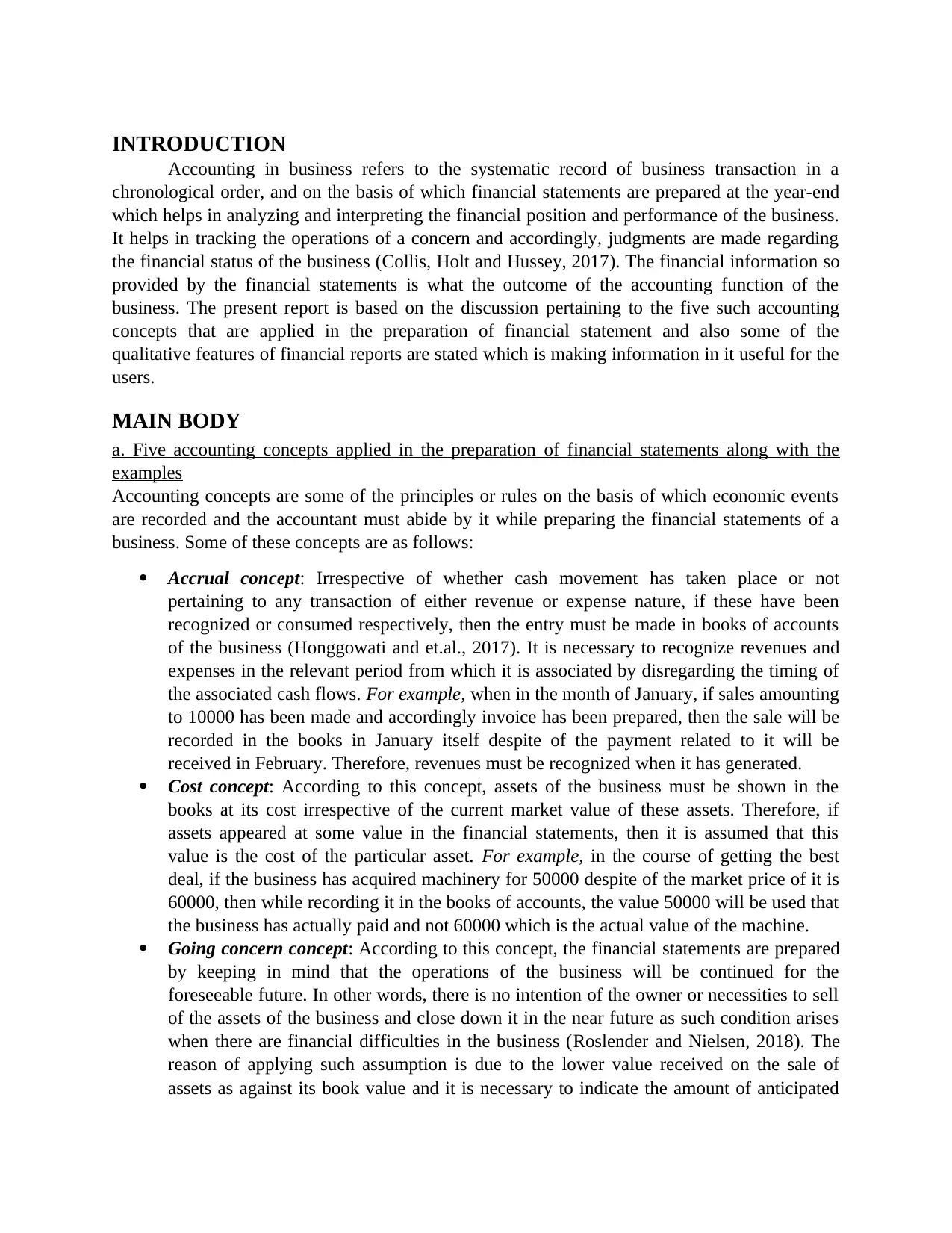
INTRODUCTION
Accounting in business refers to the systematic record of business transaction in a
chronological order, and on the basis of which financial statements are prepared at the year-end
which helps in analyzing and interpreting the financial position and performance of the business.
It helps in tracking the operations of a concern and accordingly, judgments are made regarding
the financial status of the business (Collis, Holt and Hussey, 2017). The financial information so
provided by the financial statements is what the outcome of the accounting function of the
business. The present report is based on the discussion pertaining to the five such accounting
concepts that are applied in the preparation of financial statement and also some of the
qualitative features of financial reports are stated which is making information in it useful for the
users.
MAIN BODY
a. Five accounting concepts applied in the preparation of financial statements along with the
examples
Accounting concepts are some of the principles or rules on the basis of which economic events
are recorded and the accountant must abide by it while preparing the financial statements of a
business. Some of these concepts are as follows:
Accrual concept: Irrespective of whether cash movement has taken place or not
pertaining to any transaction of either revenue or expense nature, if these have been
recognized or consumed respectively, then the entry must be made in books of accounts
of the business (Honggowati and et.al., 2017). It is necessary to recognize revenues and
expenses in the relevant period from which it is associated by disregarding the timing of
the associated cash flows. For example, when in the month of January, if sales amounting
to 10000 has been made and accordingly invoice has been prepared, then the sale will be
recorded in the books in January itself despite of the payment related to it will be
received in February. Therefore, revenues must be recognized when it has generated.
Cost concept: According to this concept, assets of the business must be shown in the
books at its cost irrespective of the current market value of these assets. Therefore, if
assets appeared at some value in the financial statements, then it is assumed that this
value is the cost of the particular asset. For example, in the course of getting the best
deal, if the business has acquired machinery for 50000 despite of the market price of it is
60000, then while recording it in the books of accounts, the value 50000 will be used that
the business has actually paid and not 60000 which is the actual value of the machine.
Going concern concept: According to this concept, the financial statements are prepared
by keeping in mind that the operations of the business will be continued for the
foreseeable future. In other words, there is no intention of the owner or necessities to sell
of the assets of the business and close down it in the near future as such condition arises
when there are financial difficulties in the business (Roslender and Nielsen, 2018). The
reason of applying such assumption is due to the lower value received on the sale of
assets as against its book value and it is necessary to indicate the amount of anticipated
Accounting in business refers to the systematic record of business transaction in a
chronological order, and on the basis of which financial statements are prepared at the year-end
which helps in analyzing and interpreting the financial position and performance of the business.
It helps in tracking the operations of a concern and accordingly, judgments are made regarding
the financial status of the business (Collis, Holt and Hussey, 2017). The financial information so
provided by the financial statements is what the outcome of the accounting function of the
business. The present report is based on the discussion pertaining to the five such accounting
concepts that are applied in the preparation of financial statement and also some of the
qualitative features of financial reports are stated which is making information in it useful for the
users.
MAIN BODY
a. Five accounting concepts applied in the preparation of financial statements along with the
examples
Accounting concepts are some of the principles or rules on the basis of which economic events
are recorded and the accountant must abide by it while preparing the financial statements of a
business. Some of these concepts are as follows:
Accrual concept: Irrespective of whether cash movement has taken place or not
pertaining to any transaction of either revenue or expense nature, if these have been
recognized or consumed respectively, then the entry must be made in books of accounts
of the business (Honggowati and et.al., 2017). It is necessary to recognize revenues and
expenses in the relevant period from which it is associated by disregarding the timing of
the associated cash flows. For example, when in the month of January, if sales amounting
to 10000 has been made and accordingly invoice has been prepared, then the sale will be
recorded in the books in January itself despite of the payment related to it will be
received in February. Therefore, revenues must be recognized when it has generated.
Cost concept: According to this concept, assets of the business must be shown in the
books at its cost irrespective of the current market value of these assets. Therefore, if
assets appeared at some value in the financial statements, then it is assumed that this
value is the cost of the particular asset. For example, in the course of getting the best
deal, if the business has acquired machinery for 50000 despite of the market price of it is
60000, then while recording it in the books of accounts, the value 50000 will be used that
the business has actually paid and not 60000 which is the actual value of the machine.
Going concern concept: According to this concept, the financial statements are prepared
by keeping in mind that the operations of the business will be continued for the
foreseeable future. In other words, there is no intention of the owner or necessities to sell
of the assets of the business and close down it in the near future as such condition arises
when there are financial difficulties in the business (Roslender and Nielsen, 2018). The
reason of applying such assumption is due to the lower value received on the sale of
assets as against its book value and it is necessary to indicate the amount of anticipated
⊘ This is a preview!⊘
Do you want full access?
Subscribe today to unlock all pages.

Trusted by 1+ million students worldwide
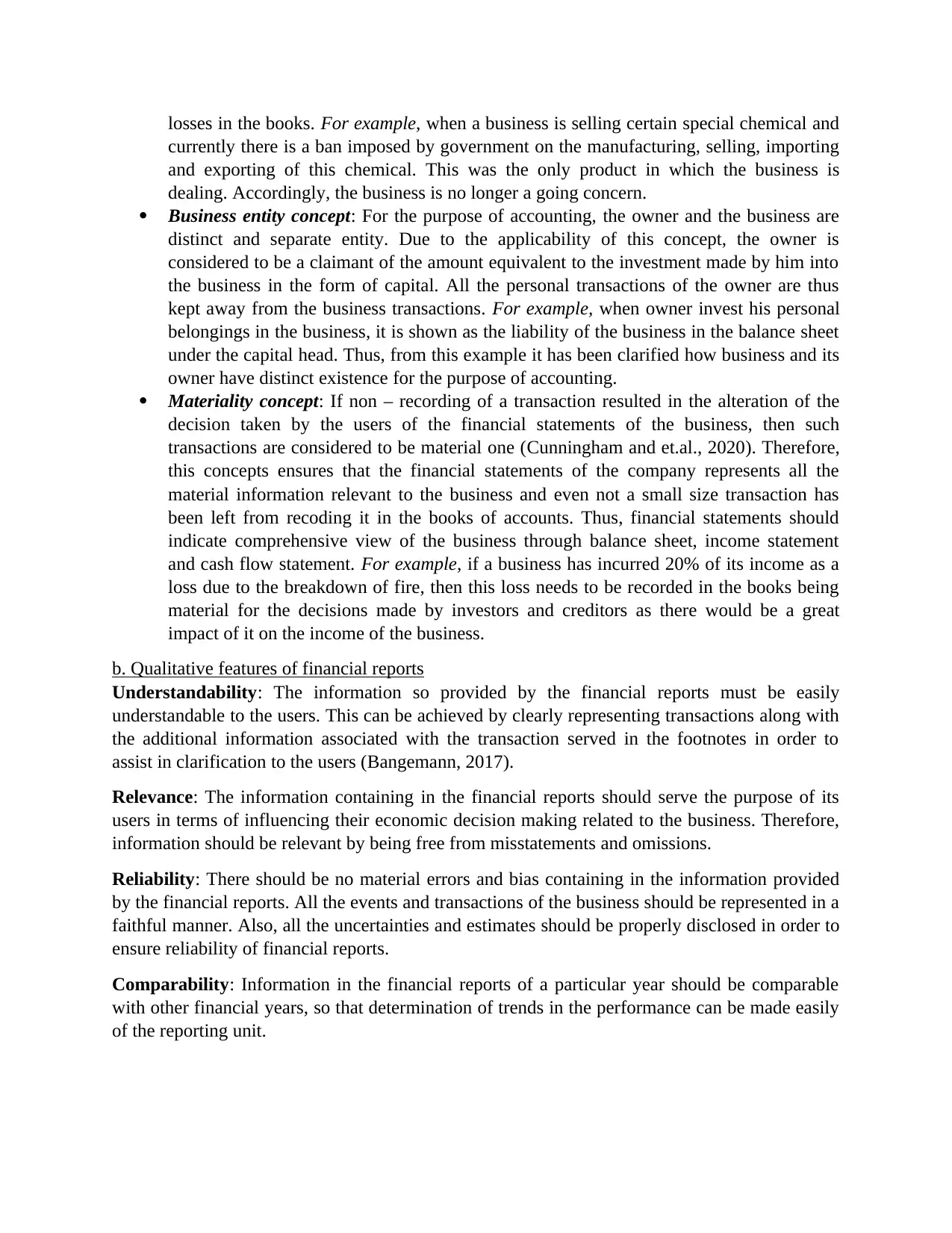
losses in the books. For example, when a business is selling certain special chemical and
currently there is a ban imposed by government on the manufacturing, selling, importing
and exporting of this chemical. This was the only product in which the business is
dealing. Accordingly, the business is no longer a going concern.
Business entity concept: For the purpose of accounting, the owner and the business are
distinct and separate entity. Due to the applicability of this concept, the owner is
considered to be a claimant of the amount equivalent to the investment made by him into
the business in the form of capital. All the personal transactions of the owner are thus
kept away from the business transactions. For example, when owner invest his personal
belongings in the business, it is shown as the liability of the business in the balance sheet
under the capital head. Thus, from this example it has been clarified how business and its
owner have distinct existence for the purpose of accounting.
Materiality concept: If non – recording of a transaction resulted in the alteration of the
decision taken by the users of the financial statements of the business, then such
transactions are considered to be material one (Cunningham and et.al., 2020). Therefore,
this concepts ensures that the financial statements of the company represents all the
material information relevant to the business and even not a small size transaction has
been left from recoding it in the books of accounts. Thus, financial statements should
indicate comprehensive view of the business through balance sheet, income statement
and cash flow statement. For example, if a business has incurred 20% of its income as a
loss due to the breakdown of fire, then this loss needs to be recorded in the books being
material for the decisions made by investors and creditors as there would be a great
impact of it on the income of the business.
b. Qualitative features of financial reports
Understandability: The information so provided by the financial reports must be easily
understandable to the users. This can be achieved by clearly representing transactions along with
the additional information associated with the transaction served in the footnotes in order to
assist in clarification to the users (Bangemann, 2017).
Relevance: The information containing in the financial reports should serve the purpose of its
users in terms of influencing their economic decision making related to the business. Therefore,
information should be relevant by being free from misstatements and omissions.
Reliability: There should be no material errors and bias containing in the information provided
by the financial reports. All the events and transactions of the business should be represented in a
faithful manner. Also, all the uncertainties and estimates should be properly disclosed in order to
ensure reliability of financial reports.
Comparability: Information in the financial reports of a particular year should be comparable
with other financial years, so that determination of trends in the performance can be made easily
of the reporting unit.
currently there is a ban imposed by government on the manufacturing, selling, importing
and exporting of this chemical. This was the only product in which the business is
dealing. Accordingly, the business is no longer a going concern.
Business entity concept: For the purpose of accounting, the owner and the business are
distinct and separate entity. Due to the applicability of this concept, the owner is
considered to be a claimant of the amount equivalent to the investment made by him into
the business in the form of capital. All the personal transactions of the owner are thus
kept away from the business transactions. For example, when owner invest his personal
belongings in the business, it is shown as the liability of the business in the balance sheet
under the capital head. Thus, from this example it has been clarified how business and its
owner have distinct existence for the purpose of accounting.
Materiality concept: If non – recording of a transaction resulted in the alteration of the
decision taken by the users of the financial statements of the business, then such
transactions are considered to be material one (Cunningham and et.al., 2020). Therefore,
this concepts ensures that the financial statements of the company represents all the
material information relevant to the business and even not a small size transaction has
been left from recoding it in the books of accounts. Thus, financial statements should
indicate comprehensive view of the business through balance sheet, income statement
and cash flow statement. For example, if a business has incurred 20% of its income as a
loss due to the breakdown of fire, then this loss needs to be recorded in the books being
material for the decisions made by investors and creditors as there would be a great
impact of it on the income of the business.
b. Qualitative features of financial reports
Understandability: The information so provided by the financial reports must be easily
understandable to the users. This can be achieved by clearly representing transactions along with
the additional information associated with the transaction served in the footnotes in order to
assist in clarification to the users (Bangemann, 2017).
Relevance: The information containing in the financial reports should serve the purpose of its
users in terms of influencing their economic decision making related to the business. Therefore,
information should be relevant by being free from misstatements and omissions.
Reliability: There should be no material errors and bias containing in the information provided
by the financial reports. All the events and transactions of the business should be represented in a
faithful manner. Also, all the uncertainties and estimates should be properly disclosed in order to
ensure reliability of financial reports.
Comparability: Information in the financial reports of a particular year should be comparable
with other financial years, so that determination of trends in the performance can be made easily
of the reporting unit.
Paraphrase This Document
Need a fresh take? Get an instant paraphrase of this document with our AI Paraphraser
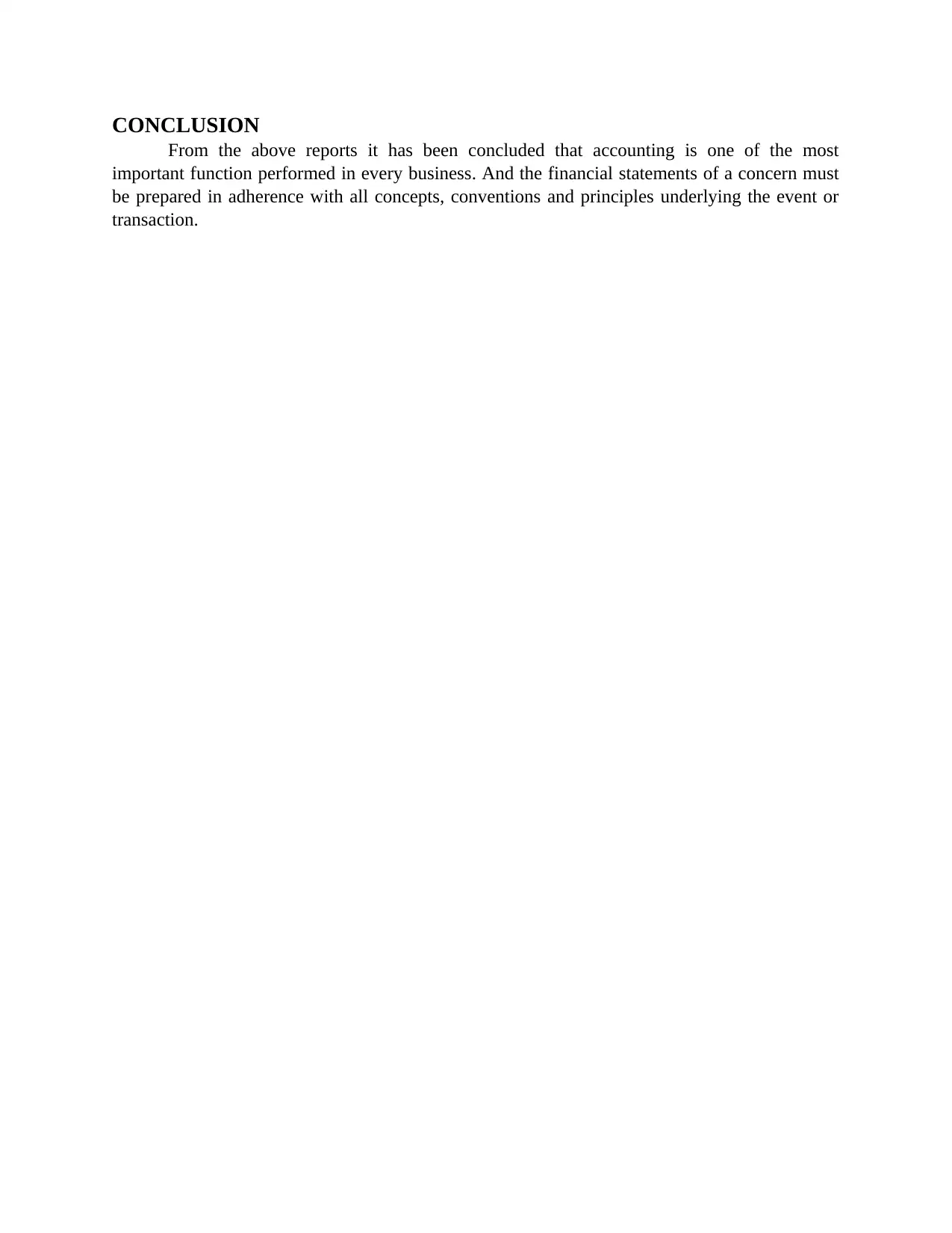
CONCLUSION
From the above reports it has been concluded that accounting is one of the most
important function performed in every business. And the financial statements of a concern must
be prepared in adherence with all concepts, conventions and principles underlying the event or
transaction.
From the above reports it has been concluded that accounting is one of the most
important function performed in every business. And the financial statements of a concern must
be prepared in adherence with all concepts, conventions and principles underlying the event or
transaction.
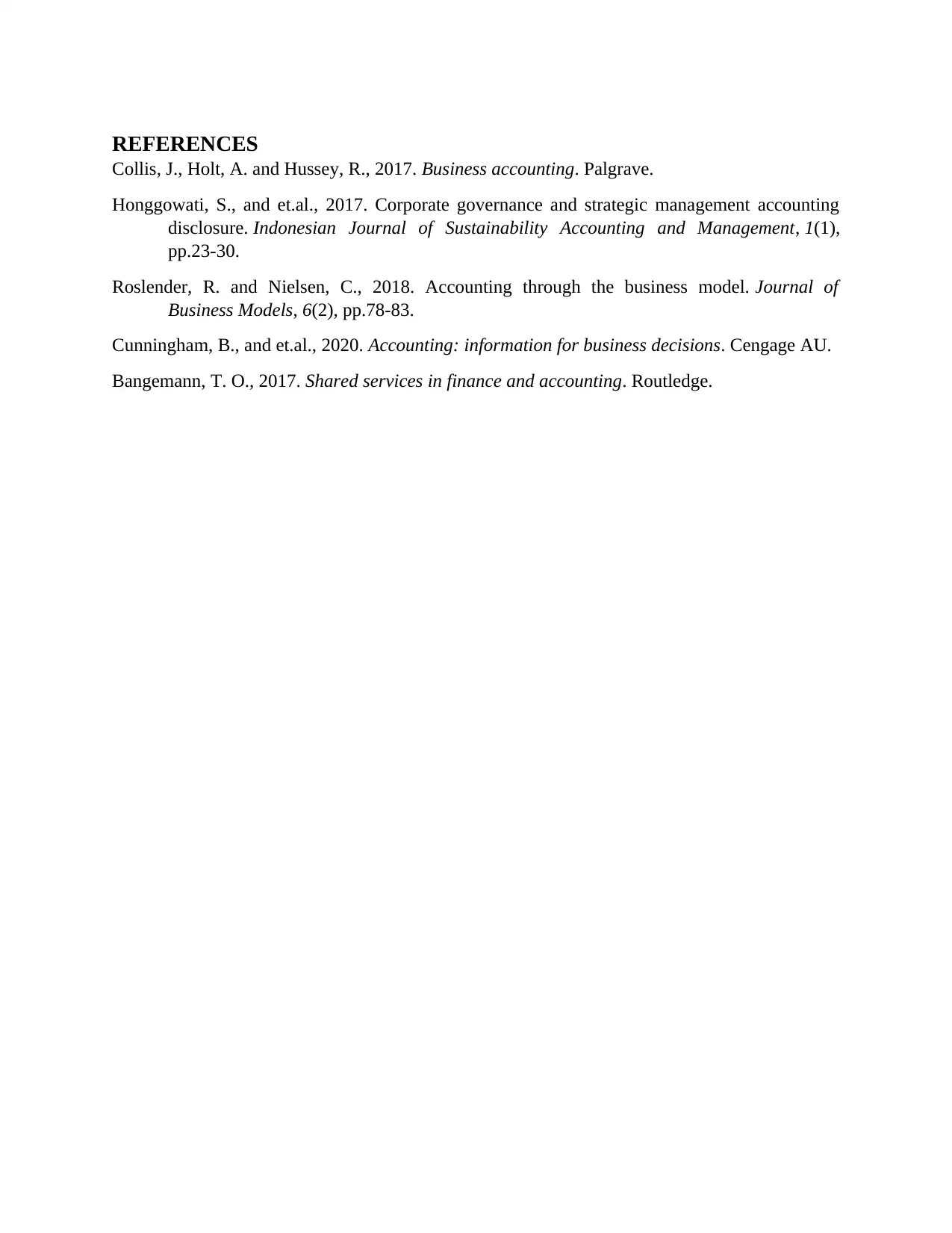
REFERENCES
Collis, J., Holt, A. and Hussey, R., 2017. Business accounting. Palgrave.
Honggowati, S., and et.al., 2017. Corporate governance and strategic management accounting
disclosure. Indonesian Journal of Sustainability Accounting and Management, 1(1),
pp.23-30.
Roslender, R. and Nielsen, C., 2018. Accounting through the business model. Journal of
Business Models, 6(2), pp.78-83.
Cunningham, B., and et.al., 2020. Accounting: information for business decisions. Cengage AU.
Bangemann, T. O., 2017. Shared services in finance and accounting. Routledge.
Collis, J., Holt, A. and Hussey, R., 2017. Business accounting. Palgrave.
Honggowati, S., and et.al., 2017. Corporate governance and strategic management accounting
disclosure. Indonesian Journal of Sustainability Accounting and Management, 1(1),
pp.23-30.
Roslender, R. and Nielsen, C., 2018. Accounting through the business model. Journal of
Business Models, 6(2), pp.78-83.
Cunningham, B., and et.al., 2020. Accounting: information for business decisions. Cengage AU.
Bangemann, T. O., 2017. Shared services in finance and accounting. Routledge.
⊘ This is a preview!⊘
Do you want full access?
Subscribe today to unlock all pages.

Trusted by 1+ million students worldwide
1 out of 6
Related Documents
Your All-in-One AI-Powered Toolkit for Academic Success.
+13062052269
info@desklib.com
Available 24*7 on WhatsApp / Email
![[object Object]](/_next/static/media/star-bottom.7253800d.svg)
Unlock your academic potential
Copyright © 2020–2025 A2Z Services. All Rights Reserved. Developed and managed by ZUCOL.





